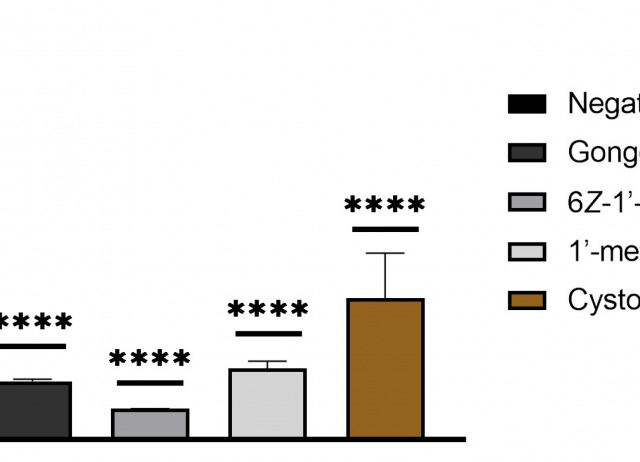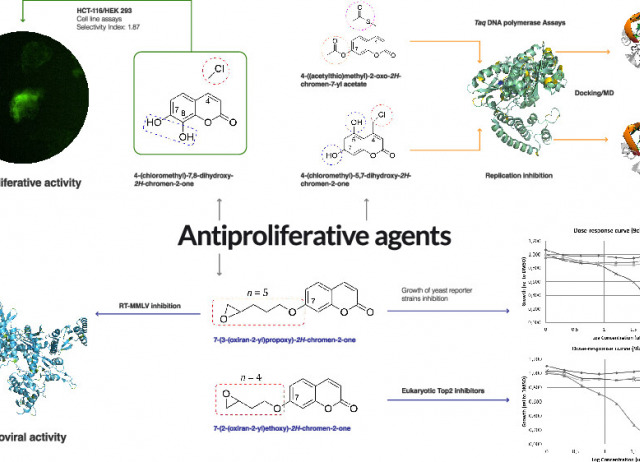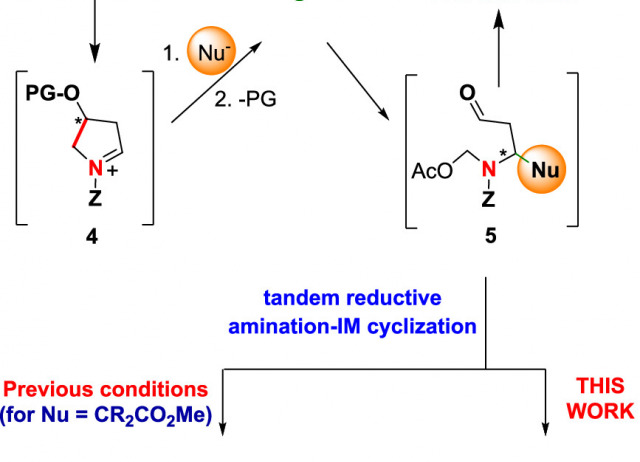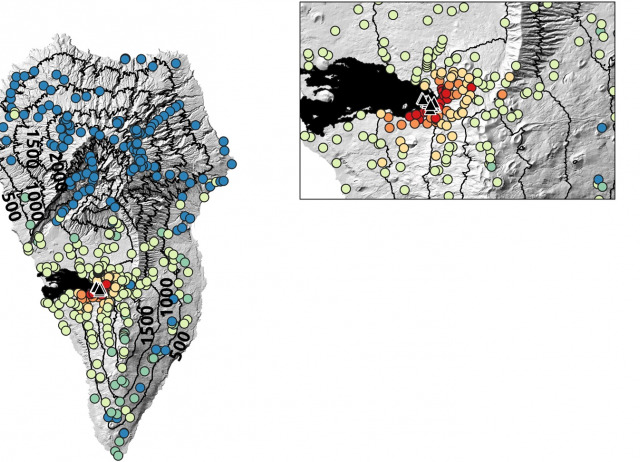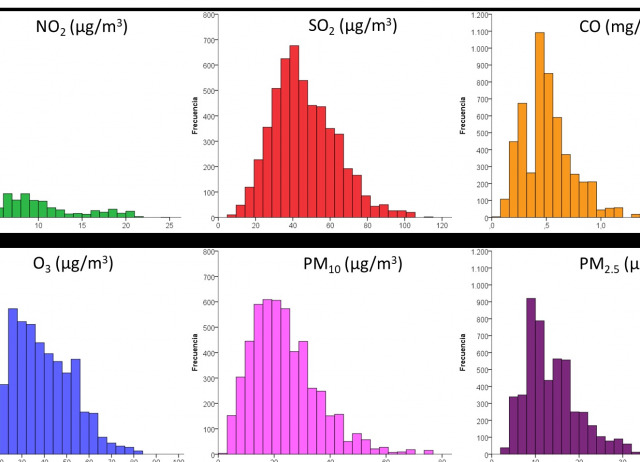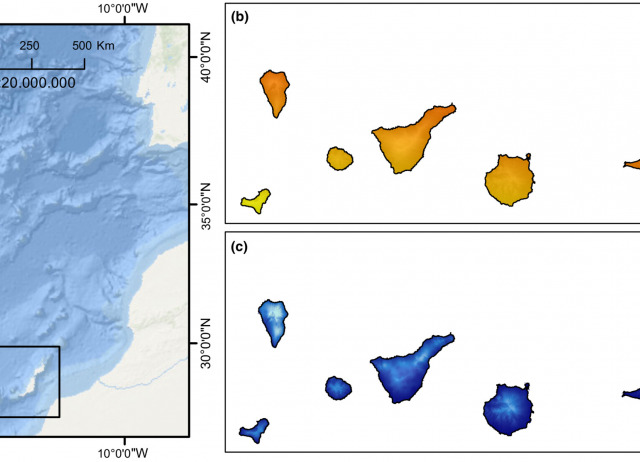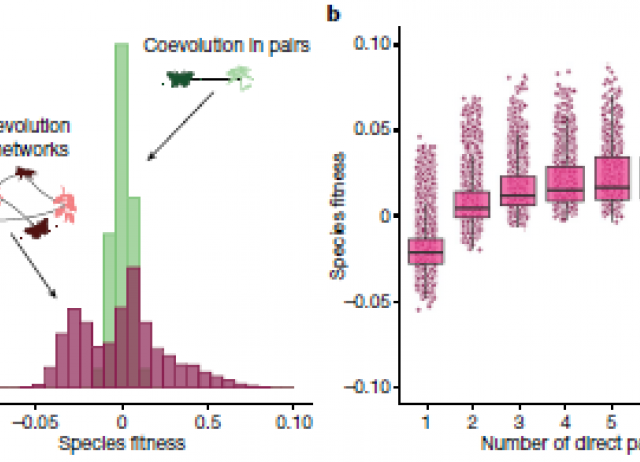
Indirect effects shape species fitness in coevolved mutualistic networks
Ecological interactions are one of the main forces that sustain Earth’s biodiversity. A major challenge for studies of ecology and evolution is to determine how these interactions affect the fitness of species when we expand from studying isolated, pairwise interactions to include networks of interacting species1,2,3,4. In networks, chains of effects caused by a range of species have an indirect effect on other species they do not interact with directly, potentially affecting the fitness outcomes of a variety of ecological interactions (such as mutualism)5,6,7. Here we apply analytical techniques and numerical simulations to 186 empirical mutualistic networks and show how both direct and indirect effects alter the fitness of species coevolving in these networks. Although the fitness of species usually increased with the number of mutualistic partners, most of the fitness variation across species was driven by indirect effects. We found that these indirect effects prevent coevolving species from adapting to their mutualistic partners and to other sources of selection pressure in the environment, thereby decreasing their fitness. Such decreases are distributed in a predictable way within networks: peripheral species receive more indirect effects and experience higher reductions in fitness than central species. This topological effect was also evident when we analysed an empirical study of an invasion of pollination networks by honeybees. As honeybees became integrated as a central species within networks, they increased the contribution of indirect effects on several other species, reducing their fitness. Our study shows how and why indirect effects can govern the adaptive landscape of species-rich mutualistic assemblages.
Cosmo, Leandro G.; Assis, Ana Paula A.; de Aguiar, Marcus A. M.; Pires, Mathias M.; Valido, Alfredo; Jordano, Pedro; Thompson, John N.; Bascompte, Jordi; Guimarães Jr., Paulo R.
Marine Meroterpenoids Isolated from Gongolaria abies-marina Induce Programmed Cell Death in Naegleria fowleri
Naegleria fowleri is the causative agent of a central nervous system affecting disease called primary amoebic meningoencephalitis. It is a fulminant disease with a rapid progression that affects mainly children and young adults who report previous water exposure. Current treatment options are not totally effective and involve several side effects. In this work, six meroterpenoids isolated from the brown algae Gongolaria abies-marina were evaluated against N. fowleri. Gongolarone B (1), 6Z-1′-methoxyamentadione (2), and 1′-methoxyamentadione (3) were the most active molecules against N. fowleri with IC50 values between 13.27 ± 0.96 µM and 21.92 ± 1.60 µM. However, cystomexicone B (6) was the molecule with the highest selectivity index (>8.5). Moreover, all these compounds induced different cellular events compatible with the apoptosis-like PCD process, such as chromatin condensation, damages at the mitochondrial level, cell membrane disruption, and production of reactive oxygen species (ROS). Therefore, G. abies-marina could be considered as a promising source of active molecules to treat the N. fowleri infections.
Arberas-Jiménez, Íñigo; Rodríguez-Expósito, Rubén L.; San Nicolás-Hernández, Desirée; Chao-Pellicer, Javier; Sifaoui, Inés; Díaz-Marrero, Ana R.; Fernández, José J.; Piñero, José E.; Lorenzo-Morales, Jacob.
Synthesis of Structurally Related Coumarin Derivatives as Antiproliferative Agents
A library of structurally related coumarins was generated through synthesis reactions and chemical modification reactions to obtain derivatives with antiproliferative activity both in vivo and in vitro. Out of a total of 35 structurally related coumarin derivatives, seven of them showed inhibitory activity in in vitro tests against Taq DNA polymerase with IC50 values lower than 250 μM. The derivatives 4-(chloromethyl)-5,7-dihydroxy-2H-chromen-2-one (2d) and 4-((acetylthio)methyl)-2-oxo-2H-chromen-7-yl acetate (3c) showed the most promising anti-polymerase activity with IC50 values of 20.7 ± 2.10 and 48.25 ± 1.20 μM, respectively. Assays with tumor cell lines (HEK 293 and HCT-116) were carried out, and the derivative 4-(chloromethyl)-7,8-dihydroxy-2H-chromen-2-one (2c) was the most promising, with an IC50 value of 8.47 μM and a selectivity index of 1.87. In addition, the derivatives were evaluated against Saccharomyces cerevisiae strains that report about common modes of actions, including DNA damage, that are expected for agents that cause replicative stress. The coumarin derivatives 7-(2-(oxiran-2-yl)ethoxy)-2H-chromen-2-one (5b) and 7-(3-(oxiran-2-yl)propoxy)-2H-chromen-2-one (5c) caused DNA damage in S. cerevisiae. The O-alkenylepoxy group stands out as that with the most important functionality within this family of 35 derivatives, presenting a very good profile as an antiproliferative scaffold. Finally, the in vitro antiretroviral capacity was tested through RT-PCR assays. Derivative 5c showed inhibitory activity below 150 μM with an IC50 value of 134.22 ± 2.37 μM, highlighting the O-butylepoxy group as the functionalization responsible for the activity.
Bruna-Haupt, Ezequiel F.; Perretti, Marcelle D.; Garro, Hugo A.; Carrillo Fumero, Romen; Machín, Félix; Lorenzo-Castrillejo, Isabel; Gutiérrez, Lucas; Vega-Hissi, Esteban G.; Mamberto, Macarena; Menacho-Marquez, Mauricio; Fernández, Claudio O.; García, Celina; Pungitore, Carlos R.
From reactive species to disease development: Effect of oxidants and antioxidants on the cellular biomarkers
The influence of modern lifestyle, diet, exposure to chemicals such as phytosanitary substances, together with sedentary lifestyles and lack of exercise play an important role in inducing reactive stress (RS) and disease. The imbalance in the production and scavenging of free radicals and the induction of RS (oxidative, nitrosative, and halogenative) plays an essential role in the etiology of various chronic pathologies, such as cardiovascular diseases, diabetes, neurodegenerative diseases, and cancer. The implication of free radicals and reactive species injury in metabolic disturbances and the onset of many diseases have been accumulating for several decades, and are now accepted as a major cause of many chronic diseases. Exposure to elevated levels of free radicals can cause molecular structural impact on proteins, lipids, and DNA, as well as functional alteration of enzyme homeostasis, leading to aberrations in gene expression. Endogenous depletion of antioxidant enzymes can be mitigated using exogenous antioxidants. The current interest in the use of exogenous antioxidants as adjunctive agents for the treatment of human diseases allows a better understanding of these diseases, facilitating the development of new therapeutic agents with antioxidant activity to improve the treatment of various diseases. Here we examine the role that RS play in the initiation of disease and in the reactivity of free radicals and RS in organic and inorganic cellular components.
Curieses Andrés, Celia María; Pérez de Lastra, José Manuel; Andrés Juan, Celia; Plou Gasca, Francisco José; Pérez-Lebeña, Eduardo.
Conversion of Hydroxyproline “Doubly Customizable Units” to Hexahydropyrimidines: Access to Conformationally Constrained Peptides
The efficient transformation of hydroxyproline “doubly customizable units” into rigid hexahydropyrimidine units takes place in good global yields and generates compounds of pharmaceutical interest. In particular, the process can readily provide access to peptidomimetics and peptides with reversed sequences or with valuable turns.
Hernández, Dácil; Porras, Marina; Boto, Alicia.
Volcanic ash deposition as a selection mechanism towards woodiness
The high proportion of woody plant species on oceanic islands has hitherto been explained mainly by gradual adaptation to climatic conditions. Here, we present a novel hypothesis that such woodiness is adaptative to volcanic ash (tephra) deposition. Oceanic islands are subject to frequent eruptions with substantial and widespread ash deposition on evolutionary time scales. We postulate that this selects for woodiness through an increased ability to avoid burial of plant organs by ash, and to re-emerge above the new land surface. We sense-checked using observations of plant occurrences and distributions on La Palma (Canary Islands) in April 2022, 4 months after the end of the eruptions of the Tajogaite volcano (Cumbre Vieja ridge). In contrast to herbs and grasses, most woody plants persisted and were already in full flower in areas with 10+ cm ash deposition. Remarkably, these persisting woody plants were almost exclusively endemics.
Beierkuhnlein, Carl; Nogales, Manuel; Field, Richard; Vetaas, Ole R.; Walentowitz, Anna; Weiser, Frank; Stahlmann, Reinhold; Guerrero-Campos, María; Jentsch, Anke; Medina, Félix M.; Chiarucci, Alessandro.
Análisis de la relación entre la contaminación del aire ambiente y la gravedad de las descompensaciones por insuficiencia cardiaca en dos metrópolis españolas (Barcelona y Madrid)
Objetivos: Analizar si la exposición a contaminantes del aire en 2 grandes ciudades españolas está relacionada con la gravedad de las descompensaciones de la insuficiencia cardiaca (IC).
Método: Se estudiaron pacientes con IC descompensada en urgencias de 4 hospitales de Barcelona y 3 de Madrid. Se recogieron datos clínicos (edad, sexo, comorbilidades, situación funcional basal), atmosféricos (temperatura, presión atmosférica) y de contaminantes (SO2, NO2, CO, O3, PM10, PM2,5) el día de atención en urgencias. La gravedad de la descompensación se estimó mediante la mortalidad a 7 días (indicador primario) y la necesidad de hospitalización, mortalidad intrahospitalaria y hospitalización prolongada (indicadores secundarios). Se investigó la asociación ajustada por datos clínicos, atmosféricos y ciudad entre concentración de contaminantes y gravedad, mediante regresión logística (asunción de linealidad) y curvas spline cúbicas restringidas (no asunción de linealidad).
Resultados: Se incluyeron 5.292 descompensaciones, con edad mediana de 83 años (RIC = 76-88) y 56% mujeres. Las medianas (RIC) de los promedios diarios de contaminantes fueron: SO2 = 2,5 μg/m3 (1,4-7,0), NO2 = 43 μg/m3 (34-57), CO = 0,48 mg/m3 (0,35-0,63), O3 = 35 μg/m3 (25-48), PM10 = 22 μg/m3 (15-31) y PM2,5 = 12 μg/m3 (8-17). La mortalidad a 7 días fue del 3,9%, y la hospitalización, la mortalidad intrahospitalaria y la hospitalización prolongada, del 78,9, 6,9 y 47,5%, respectivamente. El SO2 fue el único contaminante que mostró asociación lineal con la gravedad de la descompensación, ya que cada unidad de incremento supuso una OR para necesidad de hospitalización de 1,04 (IC 95% 1,01-1,08). El estudio mediante curvas spline cúbicas restringidas tampoco mostró asociaciones nítidas entre contaminantes y gravedad, excepto para SO2 y hospitalización, con OR de 1,55 (IC 95% 1,01-2,36) y de 2,71 (IC 95% 1,13-6,49) para concentraciones de 15 y 24 μg/m3, respectivamente, en relación con una concentración de referencia de 5 μg/m3.
Conclusión: La exposición a contaminantes del aire ambiente, en un rango de concentraciones medio a bajo, en general no está relacionado con la gravedad de las descompensaciones de la IC, y solo el SO2 podría estar asociado a una mayor necesidad de hospitalización.
Benito-Lozano, Miguel; López-Ayala, Pedro; Rodríguez, Sergio; Llorens, Pere; Domínguez-Rodríguez, Alberto; Aguirre, Alfons; Alquézar, Aitor; Jacob, Javier; Gil, Víctor; Martín-Sánchez, Francisco Javier; Mir, María; Andueza, Juan Antonio; Burillo-Putze, Guillermo; Miró, Òscar.
Effects of climate change on the distribution of plant species and plant functional strategies on the Canary Islands
Aim
Oceanic islands possess unique floras with high proportions of endemic species. Island floras are expected to be severely affected by changing climatic conditions as species on islands have limited distribution ranges and small population sizes and face the constraints of insularity to track their climatic niches. We aimed to assess how ongoing climate change affects the range sizes of oceanic island plants, identifying species of particular conservation concern.
Location
Canary Islands, Spain.
Methods
We combined species occurrence data from single-island endemic, archipelago endemic and nonendemic native plant species of the Canary Islands with data on current and future climatic conditions. Bayesian Additive Regression Trees were used to assess the effect of climate change on species distributions; 71% (n = 502 species) of the native Canary Island species had models deemed good enough. To further assess how climate change affects plant functional strategies, we collected data on woodiness and succulence.
Results
Single-island endemic species were projected to lose a greater proportion of their climatically suitable area (x ̃ = −0.36) than archipelago endemics (x ̃ = −0.28) or nonendemic native species (x ̃ = −0.26), especially on Lanzarote and Fuerteventura, which are expected to experience less annual precipitation in the future. Moreover, herbaceous single-island endemics were projected to gain less and lose more climatically suitable area than insular woody single-island endemics. By contrast, we found that succulent single-island endemics and nonendemic natives gain more and lose less climatically suitable area.
Main Conclusions
While all native species are of conservation importance, we emphasise single-island endemic species not characterised by functional strategies associated with water use efficiency. Our results are particularly critical for other oceanic island floras that are not constituted by such a vast diversity of insular woody species as the Canary Islands.
Hanz, Dagmar M.; Cutts, Vanessa; Barajas-Barbosa, Martha Paola; Algar, Adam; Beierkuhnlein, Carl; Collart, Flavien; Fernández-Palacios, José María; Field, Richard; Karger, Dirk N.; Kienle, David R.; Kreft, Holger; Patiño, Jairo; Schrodt, Franziska; Steinbauer, Manuel J.; Weigelt, Patrick; Irl, Severin D. H.
First outdoor records in the Old World of the invasive drywood termite, Cryptotermes brevis (Walker, 1853) (Kalotermitidae)
Cryptotermes brevis (Walker, 1853) (Kalotermitidae), commonly called the West Indian drywood termite, is an important structural pest in many parts of the world. Almost all records of C. brevis come from timber or furniture inside human structures. Although originally described for Jamaica, this species appears to be native to the coastal desert area of Peru and Chile, where it commonly occurs outdoors in the dead wood of both living and dead trees in riparian habitats and irrigated agricultural areas. Here, we report outdoor records of C. brevis from an agricultural habitat at the western edge of the Sahara Desert, an area climatically similar to their native range in South America. This constitutes the first outdoor report of the invasive termite in the Old World. In Dakhla, Moroccan Sahara, we found these termites living in the dead wood of a Brazilian peppertree (Schinus terebinthifolia Raddi) and the hollow stems of giant reeds (Arundo donax L.). In North Africa, C. brevis is otherwise known only from structural timbers in northern Egypt. Whether this termite become a significant pest in North Africa remains to be seen.
Najjari, Aya; Taheri, Ahmed; Hernández-Teixidor, David; Wetterer, James K.
Prediction of Antifungal Activity of Antimicrobial Peptides by Transfer Learning from Protein Pretrained Models
Peptides with antifungal activity have gained significant attention due to their potential therapeutic applications. In this study, we explore the use of pretrained protein models as feature extractors to develop predictive models for antifungal peptide activity. Various machine learning classifiers were trained and evaluated. Our AFP predictor achieved comparable performance to current state-of-the-art methods. Overall, our study demonstrates the effectiveness of pretrained models for peptide analysis and provides a valuable tool for predicting antifungal peptide activity and potentially other peptide properties.
Lobo, Fernando; González, Maily Selena; Boto, Alicia; Pérez de Lastra, José Manuel.
